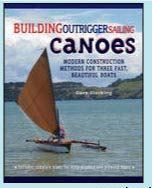Why Use a Whisker Pole, While Sailing Up Wind on Beam/Close Reach
Recently, I had the Mystic Wind out to evaluate a design modification. I set a couple of C-Clamps about 22 inches forward of the standard location of the Jib sheet fairleads. The C-Clamps were there is act as a second set of Jib Sheet fairleads for use with the Storm Jib.
The objective was to increase the angle of the storm jib with respect to the center line of the boat.
Why? When sailing in high winds and waves, the best sailing angle of attack is 20 to 30 deg of the wave front, with the winds on a beam reach to a close reach. By pulling the storm jib out (increasing the angle), the storm jib now approaches the same angle as the main sail in high winds and waves, while sailing on beam reach to a close reach.
The Theory/Principle
Optimum power is harvested when a sail is 45 deg to the wind. When a sail is extended out too far (45+ deg), less than optimum power can be harvested. When a sail is pulled in too far (45- deg), less than optimum power can be harvested, and at the same time, an unnecessary heeling factor will be generated.
When sailing in high winds, the jib sail is pulled tight and flat at an angle that is designed to harvest optimum power when the sailboat is traveling close hauled, into the wind. However, when sailing in high winds and waves, the sailboat will be sailing at a close reach to a beam reach. Therefore, the jib sail, pulled tight and flat, will not be optimized to produce maximum propulsion, and at the same time, it will produce an unnecessary heeling factor; especially during a gust.
When tacking across high winds, a Jib Sail, that is pulled in tight and flat, will begin to generate power, as the bow turns to the wind. On the other hand, if the Jib Sail is pulled out at an increased angle for optimum power, while sailing at a close reach, the Jib sail will begin to decline in power generation, as the bow to turns to the wind. In as much, when sailing with a Jib, which is pulled out (angled out), the helmsman needs to take this into account; the issue is easily resolved by the helmsman.
The Desired Results:
* Propulsion Boost, via the Storm Jib Sail
* Reduce the Potential to Stall
* Reduced "heeling behavior", especially when hit with a gust
Sailboat Test Configuration:
* Storm Sail Jib
* 2nd Reef Main Sail
* 300 Lbs Water Ballast
* 120 Lbs Cargo
* Center Board Full Deployed
The results were spectacular. I had no problem with the "potential to stall" due the speed consumed while engaging large waves; followed by a slow speed recovery due to significantly increased ballast. I was able to easily retain control, pass through waves (2.5 to 3.2 Ft), and quickly regain any loss of speed. At times, I began to sail at speeds that were out right scary (no GPS data on the speed, as I had my hands full). Several times, as I passed through a wave, the bow "splashed-smacked" down on the far side of the wave; the bow was attempting to jump to the next wave front. The only time I have experienced a bow splash-smack down, was when the sailboat was configured with light amount cargo, and powered by an outboard motor.
Today, there are now two new fairleads (formerly C-Clamps) mounted 22 inches forward of the standard jib sheet fairleads.
How to make use of the same principle, via a Full Jib.
Today was an excellent day for testing and evaluating the use of a whisker pole for use when sailing up wind on a beam/close reach.
The results were mind blowing:
Sailing Wind Conditions: Moderate
* Winds 5 to 8, with gusts to 12
* Waves 0.5 to 0.8 Ft.
Sailing Configuration:
* Full Main Sail
* Full Camber ala a loose foot main sail
* Full Jib Sail, with Whisker Pole;
* Jib sail pulled tight, flat at the foot
* Jib angle 45 deg from center line of the boat
* Cargo: 520 Lbs (1st Mate: 170 Lbs; Skipper: 200 Lbs)
SAILING RESULTS: via GPS (Up Wind)
* Top speed: 6.4 MPH
* Steady Average Speed 5.3 MPH
SAILING RESULTS: via GPS (Down Wind) (Main Sail Port Side; Whisker Poled Jib Starboard Side)
* Average Speed: 4.3 MPH
I sailed for three hours, in multiple regions of the lake and I had the same incredible results all day long.
A Bonus Surprise:
I anticipated/expected that the whisker pole would need to be manually maneuvered, when tacking across the wind.
Surprise, Surprise, Surprise - every time I came across the wind, the whisker pole would rise up, with the jib clew in hand, and move to the other side, drop down, assume the position, and begin producing power - every single time, with out fail...
From here, I will improve the "connection" ends of the whisker pole and, as the saying goes, never Leave Port without it. The whisker pole will be somewhere in the cuddy.

AMF Sunbird 16 Sloop with No Whisker Pole - Jib is pulled in too far.
Above is a picture of a Sunbird out on the water. Notice the main sail is out over the gunwale. However, the Full Jib Sail is characteristically pulled in too tight. The picture shows that the skipper has attempted to allow as much of the Jib sail to extend out as possible (note the large amount of camber). However, because the Jib is pulled in too tight (nothing else the skipper can do), the Jib Sail will not generate maximum propulsion. When the Jib Sail is extended out, via a whisker pole, the Jib Sail will generate maximum propulsion and minimum heel; especially in gusty, moderate winds. |
The next two pictures above show how a short whisker pole can be employed to extend the Jib sail out to match the main sail. The jib is extended out over the gunwale while sailing on a close reach to a beam reach. |
D Snider, 1978 AMF Sunbird 16' Sloop
|








